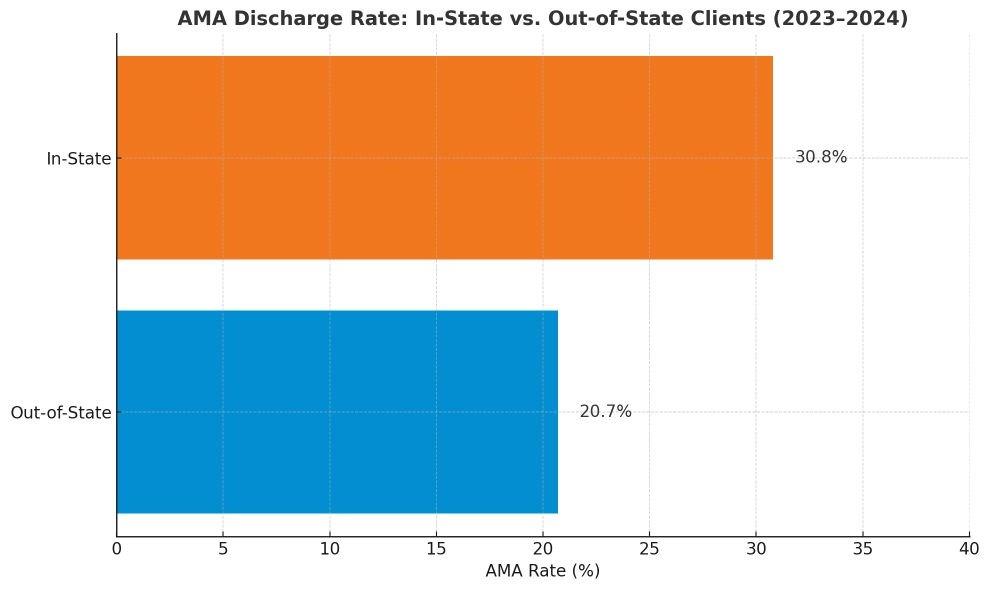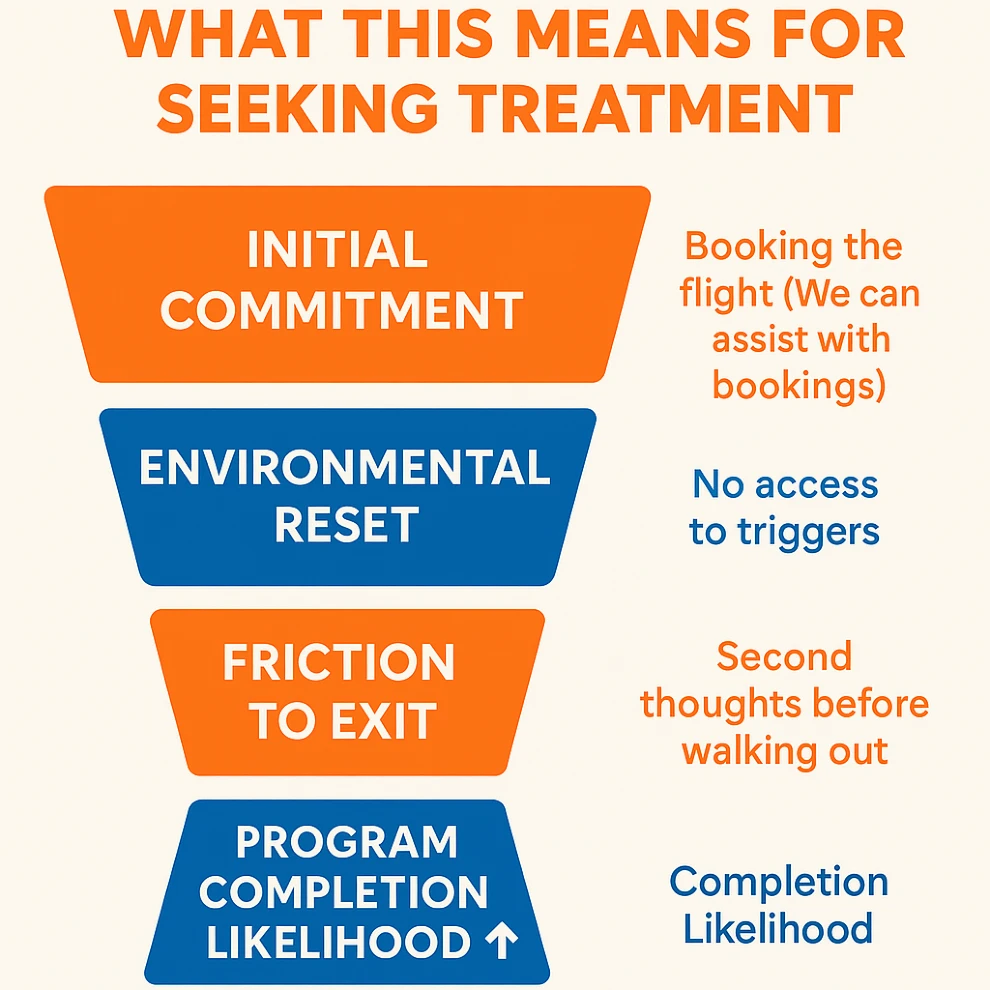An Evidence Based Report on Attending Rehab Out of State
Table of Contents
- An Evidence Based Report on Attending Rehab Out of State
- The Real Cost of Leaving Rehab Early
- Key Findings: In-State vs. Out-of-State Rehab AMA Rates
- Why Distance Changes Behavior When Attending Rehab
- Commitment Starts With Deciding to Travel for Treatment
- What This Means for Concerned Loved Ones
- Talking Points for Families and Loved Ones Seeking to Get Someone Help
- Why Travel for Treatment Works: A Closer Look
- Limitations and Considerations
- Get Started With Proven Out of State Rehab Options Today
- FAQs on Travelling for Rehab Out of State and AMA Data
When it comes to addiction treatment, success hinges on one thing above all else: staying. Every therapy session, peer group, or medication plan only works if the person attending rehab remains in the program long enough to benefit.
That’s why reducing AMA (Against Medical Advice) discharges is so critical: and why distance may be the hidden variable that changes everything.
These considerations are why our latest blog looks at recent research to discuss why travelling for out-of-state rehab makes sense in many cases, and is backed by substantial data.
Keep reading our latest resource from Find Addiction Rehabs to learn more, and please don’t hesitate to reach out confidentially with questions or to get our expert assistance with travel planning and proven treatment programs across the country.
The Real Cost of Leaving Rehab Early
Leaving AMA is more than a box on a discharge form, it’s often a detour that leads right back to relapse. For many treatment providers, in-state clients are the most at risk. When someone is struggling and can walk out the door and into a familiar environment, the path to giving up is short and often well-worn.
But what happens when that door doesn’t lead home? What if walking out means facing an airport instead of a familiar street?
That’s where the data tells a different story.
Key Findings: In-State vs. Out-of-State Rehab AMA Rates
A two-year data analysis of clients from partner treatment centers in California revealed a dramatic gap between in-state and out-of-state client outcomes. In-state admissions leaving AMA did so at a rate of 30.8%. Out-of-state admissions leaving AMA: just 20.7%.
This 10-point difference translates to a 32.8% lower risk of leaving early for clients who traveled out of state for care. It also means in-state clients were nearly 50% more likely to leave AMA.

Why Distance Changes Behavior When Attending Rehab
Traveling for treatment isn’t just about location, it’s about psychology. The moment someone agrees to enter treatment out of state, they’ve already made a deeper commitment. They’re leaving behind familiar surroundings, immediate access to triggers, enabling people or environments, and the easy ability to give up on a tough day.
That physical separation builds friction, the kind that makes it harder to act on impulse. And sometimes, that moment of friction is all it takes to prevent a premature exit.
One of the most powerful benefits of traveling is the pause it creates. That pause can be the difference between walking away and pushing through.
Commitment Starts With Deciding to Travel for Treatment
Of the many hundreds of clients in the AMA study, approximately 77% traveled from out of state. That alone speaks to a growing trend in behavioral health: families and individuals are more willing than ever to prioritize effective outcomes over local convenience.
Why does this matter? Because the data makes it clear: outcomes improve with distance.
What This Means for Concerned Loved Ones
For the families and loved ones of those seeking help, these numbers support what many have long believed anecdotally: sending someone farther from home increases their chances of staying.
Talking to a loved one? This isn’t just a stat—it’s a strategy. It’s about giving someone the best odds possible at finishing what they started.
Talking Points for Families and Loved Ones Seeking to Get Someone Help
“When people stay local, about 1 in 3 walk out early. When they travel out of state, it drops to 1 in 5.”
“That’s a 50% increase in early departures if someone doesn’t travel.”
“Recovery doesn’t happen if you leave early. Travel helps people finish.”
“Easy doesn’t get results. Distance creates space to heal.”

Why Travel for Treatment Works: A Closer Look
Psychological barriers come into play: being far from home introduces a cognitive barrier. The mental process of figuring out how to leave becomes a deterrent.
Emotional distance also helps. Separation from past environments provides the space for new behaviors to take root without constant reminders of old patterns.
There’s also a social reset. Traveling disrupts cycles of enabling or peer pressure that may exist in local settings.
And momentum builds. Getting on a plane or crossing state lines builds emotional and psychological momentum—energy that often translates into higher commitment on arrival.
Limitations and Considerations
As with any study, this one has its boundaries. The data reflects a single facility’s client base and doesn’t control for clinical severity, insurance type, or demographics.
However, the trend is clear, and aligns with anecdotal feedback across the industry. Smaller states or rural areas may see even higher AMA rates for in-state clients due to proximity and lower resistance to impulsive exits. In those cases, the case for travelling to attend rehab becomes even stronger.
Get Started With Proven Out of State Rehab Options Today
Whether you’re advising a client, guiding a family, or building a referral network: travel isn’t just a logistics question. It’s a commitment device. It’s a decision that, on average, lowers AMA risk by over 30% and gives people a real shot at recovery.
In a field where outcomes are fragile and every day counts, something as simple as a plane ticket could be the strongest step forward.
Our caring and compassionate recovery representatives offer proven treatment options at accredited top facilities, as well as support with travel planning if needed. If you (or someone you love) is looking to attend effective treatment programs that drive lasting results, please reach out to Find Addiction Rehabs confidentially now!
FAQs on Travelling for Rehab Out of State and AMA Data
Does traveling out of state really reduce AMA risk?
Yes. According to a two-year study of hundreds of clients at a Southern California treatment center, those who traveled out of state for treatment were over 30% less likely to leave against medical advice (AMA) compared to in-state clients. The AMA rate for out-of-state clients was 20.7%, while in-state clients had a 30.8% AMA rate.
What does AMA discharge mean in rehab?
An AMA (Against Medical Advice) discharge occurs when a client voluntarily leaves treatment before completing the recommended program. AMA discharges are associated with higher relapse rates and lower treatment success, making them a key metric for evaluating program retention and long-term outcomes.
Why do people stay in treatment longer when they travel?
Traveling out of state creates distance from triggers, enabling environments, and impulsive escape routes. It introduces logistical and psychological barriers that reduce the likelihood of early departure. Clients who travel often experience a stronger initial commitment and are more likely to pause and reflect before deciding to leave.
Should I send my loved one to rehab out of state?
If completing treatment is the goal, data suggests that out-of-state rehab improves the odds. Clients who traveled for care had significantly lower AMA discharge rates, indicating they were more likely to stay and finish the program. For many families, distance creates the space and focus needed for meaningful recovery.
Eric R. hails from Maine and does extensive work in the field of behavioral health as both a professional writer and passionate advocate for those suffering. From his own personal encounters with mental illness, he speaks to those seeking healthy relief from depression and anxiety and embraces wellness both personally and professionally. After losing friends and family to the darkness of suicide, Eric aims to educate and inform about the nature of treatment and render it accessible for all those seeking a way out of darkness and despair.

